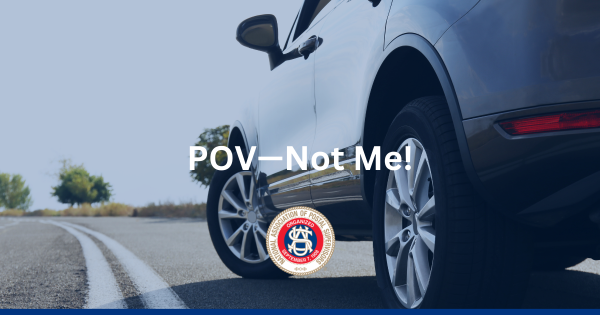POV—Not Me!
POV—Not Me!
By Brian J. Wagner
Past NAPS President
A week or two usually doesn’t go by that I don’t get a call from a NAPS member wanting to know the one big USPS question: “Do I have to drive my personal vehicle to deliver mail or do street supervision?”
You thought the question was going to be, “Are we getting raises this year?” That’s the second most-asked question.
However, for this column, let’s do one important question at a time. Can the USPS direct EAS employees to use their privately owned vehicle (POV) to do postal business? Here’s the scoop!
The short answer is “no.” Per a March 12, 2004, USPS memo from George H. Butler, USPS Employment and Labor Law office, he wrote: “The Postal Service should not force or require supervisors to use their own vehicle to perform their job responsibilities, such as street observations or route inspections.”
You would think that would be the end of this column and all would be good in the postal world. Hardly. There are some in postal leadership who constantly pressure EAS employees to use their POV to do postal business. Why?
There is a shortage of USPS admin vehicles. Street supervision needs to be done. Mail needs to be delivered. You probably can think of many other reasons why postal leaders want EAS employees to use their POV to do official postal business.
I understand not all post offices have vehicles designated for EAS employees to perform their respective USPS job duties. They should. This is the cost of doing business—postal business.
I also understand EAS employees are dedicated and, for the “good of the service” and customers, want to have mail delivered timely. But, they also want to do their jobs properly. So, many EAS employees will use their POV to get the job done. They have honorable, good intentions, but let’s look at some quotes about good intentions.
“No good deed goes unpunished.” This reflects a cynical view that even when one attempts to act for the good, it may backfire or lead to unfortunate consequences.
Then, from Tim Walberg: “Good intentions often can lead to unintended consequences.” This quote highlights the potential for well-meaning actions to have unforeseen negative effects. It acknowledges that, even with the best intentions, outcomes can be unfavorable.
What are some unfavorable outcomes for EAS employees who volunteer or who are “voluntold” to use their POV for postal business?
- If an EAS employee is injured in an accident while using their POV to perform USPS duties, regardless of fault, the employee is entitled to workers’ compensation under a particular federal law, provided the employee was acting within the scope of their employment. Could the USPS challenge this “scope” issue. If so, where does that leave the employee (NAPS member)?
- If a postal employee is involved in an automobile accident while driving their POV in an on-duty status for the USPS, the Postal Service will not pay for any damages to the employee’s POV, even if the employee is not at fault.
- The USPS will not pay for any increase in premiums that the employee’s personal insurance company may charge the employee because they used their POV in the performance of their USPS employment.
As a NAPS member, are you willing to risk these unfavorable consequences because the USPS failed to provide you the required resources— a USPS vehicle to perform your postal job effectively?
Now, the Postal Service has a POV offer they hope EAS employees won’t refuse. The USPS issued a June 1, 2015, Management Instruction (MI) titled, “EAS Privately Owned Vehicle (POV) Program,” (aka “EAS POV Program”). Under this program, EAS employees can volunteer to use their POV for official postal business with the USPS paying for some of the costs.
The “EAS POV Program” is designed to compensate eligible supervisors and other nonbargaining EAS employees—supervisors who perform street supervision and postmasters who must drive to or between remotely managed post offices—for the incremental costs associated with the use of their privately owned vehicles for work-related purposes.
Under this program, eligible employees who use their privately owned vehicles for work-related purposes will be reimbursed for mileage and the cost of adding business-use coverage or a commercial rider on their existing insurance policies, if necessary. This program is strictly voluntary; no employee is required to participate.
However, if you are a working NAPS member thinking of volunteering for the “EAS POV Program,” I recommend you think very carefully. Before signing any document, read the “fine print.” Know the specific rules and conduct you must follow under this program.
There are consequences for violating the Postal Service driving policy while under the “EAS POV Program.” Then there is the process for reimbursing claims due to damage or injuries, not to mention the financial cost to reimburse the USPS if an employee quits the “EAS POV Program” early. Truly weigh personal “benefits” against any unfavorable program consequences you may endure.
Today’s takeaways:
- EAS employees should not use their POV to do USPS work, including carrying mail or transport of mail and employees.
- Always request the USPS provide an admin vehicle to perform USPS duties. If the only postal vehicle available is a delivery or similar post-al vehicle, for safety reasons, request vehicle/driver’s training before operating the respective vehicle.
- If you volunteer to use your POV to conduct USPS business outside the “EAS POV Program,” document the miles driven and request reimburse-ment for the miles. Again, know the risks if you are in an accident.
- Don’t rush to participate in the “EAS Privately Owned Vehicle (POV) Program” until you fully understand the program’s pros and cons.
I drove my POV to Cold Stone Creamery to buy my ice-cream-flavor-of-the-month recommendation: Peanut Butter Cup Perfection. Be safe and eat more ice cream.
